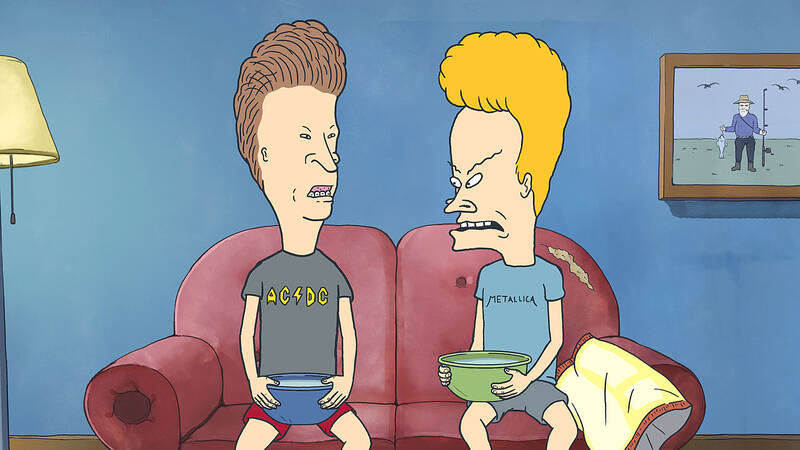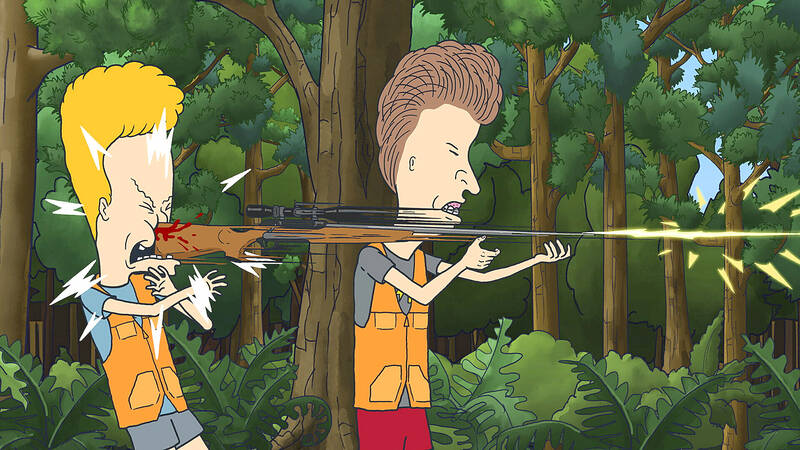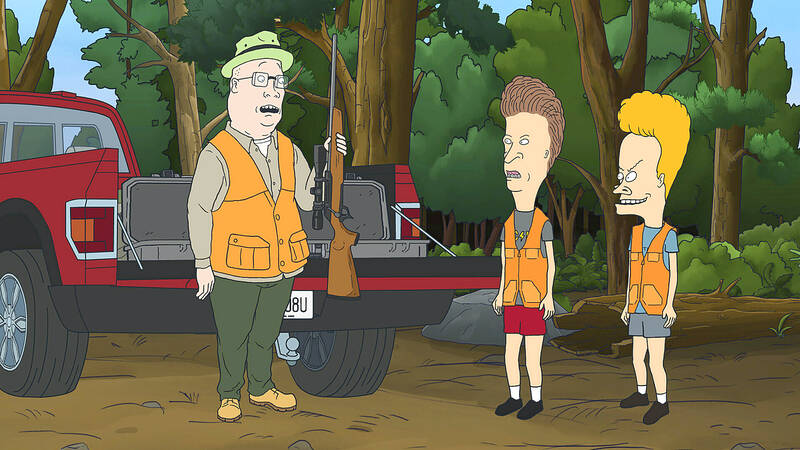The 1990s are making a comeback, with scrunchies acceptable again, Night Court back on TV and fanny packs and flannel all the rage. But it’s not the ‘90s until two of the most idiotic teenagers return, sniggering along the way.
That’s right, Beavis and Butt-Head — forever un-matured — are on the streaming platform Paramount+ these days, still mocking culture and saying things like, “That cloud looks like a butt.”
“It is almost fun sometimes to just go to that lazy part of your brain where you’re just blurting out whatever stupid thought comes out,” Mike Judge, who created the duo and voices them, says.

Photo: Paramount+ via AP
A second season of Mike Judge’s Beavis and Butt-Head kicked off this month with our heroes at school-mandated meditation class, an alternative to detention. “This sucks,” says Butt Head, the dark-haired one in braces and an AC/DC T-shirt. “Now try to empty your mind of all thoughts,” says the teacher. It is surprisingly easy.
There’s also a visit to a polling place — the boys mistake it for a strip club — and later a scheme to buy beer by spray-painting Beavis’ hair with white paint to make him look older. It goes awry, of course, when he gets on a shuttle bus to a retirement community.
VERY TIMELESS

Photo: Paramount+ via AP
The look, feel and snark of the show hasn’t changed even if there are fewer music videos these days. Judge relies on a producer to scour YouTube to find videos that might spark a spontaneous put-down. It’s all very timeless.
“That’s the beauty of Beavis and Butt-Head — no matter what decade you were born in, you’re able to find ways to connect to them and even perhaps see bits of yourselves in them,” Domenic DiMeglio, chief marketing officer for Paramount+, said.
There are a few bizarre tangents, particularly the return to an alternative universe where Beavis and Butt-Head are middle-aged. Judge devised one episode in which they marry each other without realizing it.

Photo: Paramount+ via AP
The original Beavis and Butt-Head arrived in 1993 on MTV and became an instant hit, running for seven seasons before going on hiatus in 1997. The un-dynamic duo returned with an eighth, stand-alone season in 2011, and the series was revived last year.
This show’s influence was so strong that it spawned a full-length film called Beavis and Butt-Head Do America in 1996 and another titled Beavis and Butt-Head Do the Universe last year.
Judge says he started to think about returning to his cartoon duo after the band Portugal. The Man asked him if he could introduce them with his iconic title characters at 2018’s Coachella.
“I thought of it as a way of ‘Let me see what it sounds like if my voice still sounds like them.’ And I did it. I played it back and it still felt like Beavis and Butt-Head. And so that’s partly what got me thinking about doing this again.”
The targets have changed, even if some show principles have not. If something is already funny, it’s usually not a good target. And being overexposed is usually a green light. So yesterday’s Axl Rose became today’s Jack Harlow.
This season sees Beavis and Butt-Head dunk on Lil Nas X, Audrey Nuna, Bill Gates, Ronald Reagan and even the Buddha. There’s a bizarre scene in which the boys annoy Jesus and Ganesh on an astral plane so much that the deities take turns punching the boys.
CLEVER SOCIAL COMMENTARY
Judge came up with the original concept at a time when TV was filled with yuppies — The Cosby Show, Family Ties, The Fresh Prince of Bel-Air and Mad About You.
“Maybe some of it was in reaction to that — finding a place in comedy that was different,” he said. “But I wasn’t trying to be shocking or edgy. I was just trying to make it funny.”
There was plenty of blowback. Judge thinks Beavis and Butt-Head were badly misunderstood back then by some people who accused it of contributing to all sorts of poor teen behavior. Judge even got death threats.
The cartoon duo have returned to a vastly different media landscape, one they had a part in cracking open. Can two snarky teens with little social consciousness have the ability to cut through the online hype?
Yes, says Paramount+: “Beavis and Butt-Head have been doing clever social commentary long before it was cool in the age of social media and their no-filter, blissfully ignorant POV has always been part of this duo’s DNA,” DiMeglio said.
One thing the show will not do is wade into politics. In a recent episode, Beavis and Butt-Head go hunting — “The outdoors sucks,” says Butt-Head — and accidentally drink deer urine. This was an opportunity to raise the issue of guns, but Judge has no interest.
“I feel like this is comedy and we’re just looking for funny and just trying to give people a break from that kind of stuff. I don’t think Beavis and Butt-Head have anything to add to that conversation,” he said.
“They’re not sophisticated enough to go there. I think that’s what’s comforting about it: Just seeing some guys who don’t know any better. They don’t have much accountability. They don’t know what the word means.”

Nine Taiwanese nervously stand on an observation platform at Tokyo’s Haneda International Airport. It’s 9:20am on March 27, 1968, and they are awaiting the arrival of Liu Wen-ching (柳文卿), who is about to be deported back to Taiwan where he faces possible execution for his independence activities. As he is removed from a minibus, a tenth activist, Dai Tian-chao (戴天昭), jumps out of his hiding place and attacks the immigration officials — the nine other activists in tow — while urging Liu to make a run for it. But he’s pinned to the ground. Amid the commotion, Liu tries to

The slashing of the government’s proposed budget by the two China-aligned parties in the legislature, the Chinese Nationalist Party (KMT) and Taiwan People’s Party (TPP), has apparently resulted in blowback from the US. On the recent junket to US President Donald Trump’s inauguration, KMT legislators reported that they were confronted by US officials and congressmen angered at the cuts to the defense budget. The United Daily News (UDN), the longtime KMT party paper, now KMT-aligned media, responded to US anger by blaming the foreign media. Its regular column, the Cold Eye Collection (冷眼集), attacked the international media last month in

Feb. 10 to Feb. 16 More than three decades after penning the iconic High Green Mountains (高山青), a frail Teng Yu-ping (鄧禹平) finally visited the verdant peaks and blue streams of Alishan described in the lyrics. Often mistaken as an indigenous folk song, it was actually created in 1949 by Chinese filmmakers while shooting a scene for the movie Happenings in Alishan (阿里山風雲) in Taipei’s Beitou District (北投), recounts director Chang Ying (張英) in the 1999 book, Chang Ying’s Contributions to Taiwanese Cinema and Theater (打鑼三響包得行: 張英對台灣影劇的貢獻). The team was meant to return to China after filming, but

On a misty evening in August 1990, two men hiking on the moors surrounding Calvine, a pretty hamlet in Perth and Kinross, claimed to have seen a giant diamond-shaped aircraft flying above them. It apparently had no clear means of propulsion and left no smoke plume; it was silent and static, as if frozen in time. Terrified, they hit the ground and scrambled for cover behind a tree. Then a Harrier fighter jet roared into view, circling the diamond as if sizing it up for a scuffle. One of the men snapped a series of photographs just before the bizarre